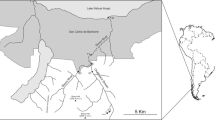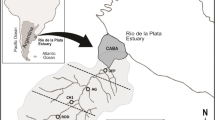Abstract
In the present study, we analyzed eight streams (four located in areas with sugarcane cultivation and four located in preserved areas) and applied a simple method to find Chironomidae indicator species that characterizes groups of sites (preserved or disturbed by sugarcane cultivation). Specimens were collected during March 2002 and November2006, using a D-net (250 µm mesh size) in areas of rapids and backwaters. The organisms collected were identified to morphotypes level. In preserved streams, Parametriocnemus sp., Ablabesmyia (Karelia) sp., and Endotribelos spp. had high densities. Chironomus spp. and Rheotanytarsus spp. were dominant in streams located in areas of sugarcane cultivation. The analyses of indicator species point to eight taxa in preserved streams and two taxa in the sugarcane streams. Nonmetric Multidimensional Scale analysis points to two groups, one gathered in the streams near the sugarcane plantation and the other in the preserved streams. The similarity test (Analysis of Similarity) pointed to significant differences (P < 0.05) between these groups. This agricultural activity seems to influence the Chironomidae community structure in low order streams in the Cerrado region. The identification of groups at the morphotypes level was important to establish indicator species.

Similar content being viewed by others
References
Allan, J. D., D. L. Erickson & J. Fay, 1997. The influence of catchment land use on stream integrity across multiple spatial scales. Freshwater Biology 37: 149–161.
Angelotti-Netto, A., S. Crestana, S. C. De Oliveira & R. V. R. Barbosa, 2004. Metais pesados provenientes de atividade agrícola: formas, prevenção e controle. In Espíndola, E. L. G. & E. Wendland (eds), Bacia Hidrográfica. Rima Editora, São Carlos: 1–14.
Callisto, M., P. Moreno, J. F. Gonçalves Jr., J. J. F. Leal & F. A. Esteves, 2002. Diversity and biomass of Chironomidae (Diptera) larvae in an impacted coastal lagoon in Rio de Janeiro, Brazil. Brazilian Journal of Biology 62(1): 77–84.
Callisto, M., J. F. Gonçalves & P. Moreno, 2005. Invertebrados Aquáticos como Bioindicadores. In Goulart, E. M. A. (ed.), Navegando o Rio das Velhas das Minas aos Gerais. Projeto Manuelzão, UFMG, Belo Horizonte: 555–567.
Carvalho-Filho, S. M., 2000. Colheita mecanizada: desempenho operacional e econômico em cana sem queima prévia. Ph.D. Thesis, ESALQ (USP), Piracicaba–SP, São Paulo, 108 pp. (in Portuguese with English abstract).
Carvalho, L. C. C., 1993. Perspectivas da cultura de cana-de-açúcar para a década de noventa. Produção de cana-de-açúcar. In de Câmara, G. M. S. & E. A. M. Oliveira (eds), Produção de cana-de-açúcar. FEALQ, Piracicaba: 1–17.
Companhia Nacional de Abastecimento (Conab), 2013. Acompanhamento de safra brasileira: cana-de-açúcar, segundo levantamento, agosto/2013 - Companhia Nacional de Abastecimento, Brasília.
Corbi, J. J. & S. Trivinho-Strixino, 2008. Relationship between sugar cane cultivation and stream macroinvertebrate communities: a study developed in the southeast of Brazil. Brazilian Archives of Biology and Technology 51: 569–579.
Corbi, J. J., S. Trivinho-Strixino & A. Dos Santos, 2008. Environmental evaluation of metals in sediments and dragonflies due to sugar cane cultivation in Neotropical streams. Water Air and Soil Pollution 195: 325–333.
Corbi, J. J., C. G. Froehlich, S. Trivinho-Strixino & A. Dos Santos, 2010. Bioaccumulation of metals in aquatic insects of streams located in areas with sugar cane cultivation. Quimica Nova 33: 644–648.
Corbi, J. J., P. Kleine & S. Trivinho-Strixino, 2013. Are aquatic insect species sensitive to banana plant cultivation? Ecological Indicators 25: 156–161.
Cranston, P. J., 1995. Chironomids: From Genes to Ecosystems. CSIRO, Canberra, Australian Capital Territory.
Crisci-Bispo, V. L., P. C. Bispo & C. G. Froehlich, 2007. Ephemeroptera, Plecoptera and Trichoptera assemblages in litter in a mountain stream of the Atlantic rainforest from Southeast Brazil. Revista Brasileira de Zoologia 24(3): 545–551.
Dudgeon, D., 1989. The influence of riparian vegetation on the functional organization of four Hong Kong stream communities. Hydrobiologia 179: 183–194.
Dufrêne, M. & P. Legendre, 1997. Species assemblages and indicator species: the need for a flexible asymmetrical approach. Ecological Monographs 67(3): 345–366.
Eggermont, H. & O. Heiri, 2012. The chironomid-temperature relationship: expression in nature and palaeoenvironmental implications. Biological Reviews 87: 430–456.
Entrekin, S. A., J. B. Wallace & S. L. Eggert, 2007. The response of Chironomidae (Diptera) to a long-term exclusion of terrestrial organic matter. Hydrobiologia 575: 401–413.
Epler, J. H., 1995. Identification manual for the larval Chironomidae of Florida. Revised edition. Tallahassee, Final Report DEP Contr. No.WM 579, St. Fla, Department of Environmental Protection, Division Wat. Facilities: 319 p.
Ferrington, L. C., 2008. Global diversity of non-biting midges (Chironomidae; Insecta-Diptera) in freshwater. Hydrobiologia 595: 447–455.
Ferrington Jr., L. C., R. G. Kavanaugh, F. J. Schmidt & J. L. Kavanaugh, 1995. Habitat separation among Chironomidae (Diptera) in Big Springs. Journal of the Kansas Entomological Society 68: 152–165.
Fontoura, A. P., 1985. Manual de vigilância da qualidade das águas superficiais. Avaliação biológica da qualidade da água. Instituto de zoologia “Dr. Augusto Nobre”. Faculdade de Ciências – Universidade do Porto, Porto – Portugal: 38 pp.
Freire, C. F. & A. A. Fonseca-Gessner, 2002. Larvas de Chironomidae (Diptera) na microbacia do Ribeirão Canchim, São Carlos, SP, Brasil. Entomología y Vectores 8: 17–429. (in Portuguese with English abstract).
Hammer, O., D. A. T. Harper, P. D. Ryan, 2001. PAST: Paleontological Statistics software package for education and data analysis. Paleontologica Eletronica.
Institute of Agro-industrial Development, (1998). Indicadores de desempenho da agroindústria canavieira – safra/97/98. Ribeirão Preto, IDEA, 1998: 116 p
Karouna-Renier, N. K. & D. W. Sparling, 2001. Relationships between ambient geochemistry, watershed land-use and trace metal concentrations in aquatic invertebrates living in storm water treatment ponds. Environmental Pollution 112: 183–192.
Kleine, P. & S. Trivinho-Strixino, 2005. Chironomidae and other aquatic macroinvertebrates of a first order stream: community response after habitat fragmentation. Acta Limnologica Brasiliensia 17: 81–90.
Lindegaard, C., 1995. Classification of water-bodies and pollution. In Armitage, P., P. Cranston & L. C. V. Pinder (eds), The Chironomidae. Chapman and Hall, London: 385–404.
Maitland, P. S., 1979. The distribution of zoobenthos and sediments in Loch Leven, Kinross, Scotland. Archives fur Hydrobiologie 5: 98–125.
Martins, S. J., 2001. Recuperação de matas ciliares, primeira ed. Editora Conceito, Viçosa, MG.
Merrit, R. W. & K. W. Cummins, 1996. An Introduction to Aquatic Insects of North America. Kendall-hunt, Dubuque, Iowa.
Molozzi, J., M. J. Feio, F. Salas, J. C. Marques & M. Callisto, 2012. Development and test of a statistical model for the ecological assessment of tropical reservoirs based on benthic macroinvertebrates. Ecological Indicators 23: 155–165.
Morais, S. S., J. Molozzi, A. L. Viana, T. H. Viana & M. Callisto, 2010. Diversity of larvae of littoral Chironomidae (Diptera: Insecta) and their role as bioindicators in urban reservoirs of different trophic levels. Brazilian Journal of Biology 70: 995–1004.
Nery, M. S., 2000. Desempenhos operacional e econômico de uma colhedora em cana crua. Ph.D. Thesis, Universidade de São Paulo (USP): 108 pp. (in Portuguese with English abstract).
Nicacio, G. & L. Juen, 2015. Chironomids as indicators in freshwater ecosystems: an assessment of the literature. Insect Conservation and Diversity 8: 393–403.
Primavesi, O., A. R. Freitas, A. C. Primavesi & H. T. Oliveira, 2002. Water quality of the Canchim’s Creek watershed in São Carlos, SP, Brazil, occupied by beef and dairy cattle activities. Brazilian Archives of Biology and Technology 45: 209–217.
Pringle, C. M., M. C. Freeman & B. J. Freeman, 2000. Regional effects of hydrologic alterations on riverine macrobiota in the New World: tropical-temperate comparisons. BioScience 50: 807–823.
R Core Team, 2014. R: A language and environment for statistical computing. R Foundation for Statistical Computing, Vienna, Austria. URL http://www.R-project.org/.
Ritz, C. & J. C. Streibig, 2005. Bioassay Analysis using R. Journal of Statistical Software 12(5): 1–21.
Roque, F. O., J. J. Corbi & S. Trivinho-Strixino, 2000. Considerações sobre a utilização de larvas de Chironomidae (Diptera) na avaliação da qualidade da água de Córregos do Estado de São Paulo. In Espíndola, E. L. G., C. M. R. B. Paschoal, O. Rocha, M. B. C. Bohrer & A. L. O. Neto (eds), Ecotoxicologia perspectivas para o século XXI. Rima Editora, São Carlos: 115–126. (in Portuguese with English abstract).
Roque, F. O. & S. Trivinho-Strixino, 2001. Benthic macroinvertebrates in mesohabitats of different spatial dimensions in a first order stream (São Carlos-SP). Acta Limnologica Brasiliensia 13: 69–77.
Roque, F. O., T. Siqueira, L. M. Bini, M. C. Ribeiro, L. R. Tambosi, G. Ciocheti & S. Trivinho-Strixino, 2010. Untangling associations between chironomid taxa in Neotropical streams using local and landscape filters. Freshwater Biology 55: 847–865.
Rosa, B. F. J. V., V. C. De Oliveira & R. G. Alves, 2011. Structure and spatial distribution of the Chironomidae community in mesohabitats in a first order stream at the Poço D’Anta Municipal Biological Reserve in Brazil. Journal of Insect Science 11: 1–12.
Rosenberg, D. M., 1992. Freshwater biomonitoring and Chironomidae. Netherlands Journal of Aquatic Ecology 26: 101–122.
Sanseverino, A. M. & J. L. Nessimian, 2001. Chironomidae larvae (Diptera) in submerged litter accumulations in a first order stream of the Atlantic Forest (Rio de Janeiro, Brazil). Revista Brasileira de Entomologia 52(1): 95–104.
Strayer, D., 2013. Endangered freshwater invertebrates. In Levin, S. A. (ed.), Encyclopedia of Biodiversity, 2nd ed. Academic Press, Amsterdam: 176–187.
Tang, H., M. Y. Song, W. S. Cho, Y. S. Park & T. S. Chon, 2009. Species abundance distribution of benthic chironomids and other macroinvertebrates across different levels of pollution in streams. Annales de Limnologie - International Journal of Limnology 46: 53–66.
Trivinho-Strixino, S. & G. Strixino, 1995. Larvas de Chironomidae (Diptera) do Estado de São Paulo: Guia de identificação e diagnose de gêneros. UFSCar, São Carlos: 227 pp
Trivinho-Strixino, S., 2011. Larvas de Chironomidae: guia de identificação. São Carlos: Departamento de Hidrobiologia/Lab. De Entomologia Aquática, Universidade Federal de São Carlos: 377 pp.
Acknowledgments
The authors gratefully acknowledge the fruitful suggestions of Professor Pedro P. Corbi and Dra. Vanessa Colombo-Corbi. The authors also acknowledge the financial support provided by CAPES and BIOTA-FAPESP (São Paulo State Research Foundation, Brazil).
Author information
Authors and Affiliations
Corresponding author
Additional information
Handling editor: Checo Colón-Gaud
This paper has not been submitted elsewhere in identical or similar form, nor will it be during the first 3 months after its submission to Hydrobiologia.
Rights and permissions
About this article
Cite this article
Corbi, J.J., Trivinho-Strixino, S. Chironomid species are sensitive to sugarcane cultivation. Hydrobiologia 785, 91–99 (2017). https://doi.org/10.1007/s10750-016-2908-2
Received:
Revised:
Accepted:
Published:
Issue Date:
DOI: https://doi.org/10.1007/s10750-016-2908-2




